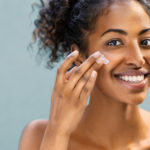By Melissa Barnett, OD, FAAO, FSLS, FBCLA

July 8, 2020
Many of your patients use facial skincare products that are negatively impacting their eyes.
Here is the essential patient education to provide about the skincare products to choose, and the ingredients to avoid, to keep their eyes healthy and comfortable.
An Essential Conversation for All & Especially for Dry Eye & CL Wearers
For those with dry eye and/or contact-lens wearers, it is important to ask which products are being used for the face and eyes. If there is makeup debris around the eyelids, it is an easy conversation starter to discuss the importance of products and makeup removal. For my severe dry eye patients, it is even more important to optimize the ocular surface.
Many cosmetic products contain chemicals which may increase ocular irritation, blepharitis, meibomian gland toxicity and even cause, or exacerbate, dry eye disease.
Most women wear cosmetics and both men and women wash their face with a product, so most everyone uses cosmetic products around the eyes. Thus, it is pertinent to discuss product use with all patients, not only those with ocular allergies. However, if a patient has allergies and/or is sensitive to products, it is even more important to discuss specific products.
Any product that a person uses on their face and around the eyes has the potential to cause problems. Men may think that since they are not using “cosmetics” they don’t need to worry about ingredients. However, the products they use may have ingredients that are unfriendly to the ocular surface. For example, a face wash, anti-aging product or sunscreen could be irritating for both men and women.
Teach Patients to Be Savvy About Reading Labels
A significant problem is that, according to the FDA, “ingredients must be declared in descending order of predominance.” However, any ingredient less than 1 percent of total volume may be listed in any order.
The most common eye irritants are:
Alcohol
Argireline (acetyl hexapeptinde-3, Lipotec)
Benzalkonium Chloride (BAK)
Butylene Glycol
Ethylenediaminetetraacetic Acid (EDTA)
Formaldehyde and Formaldehyde donors
Isopropyl Cloprostenate
Parabens
Phenoxyethanol
Retinol
It is beneficial to educate about ingredients first, and provide patients a list or resources of ingredients to avoid. I then recommend specific eyelid hygiene products for my patients.
Specific Products to Recommend
I recommend specific products and provide a convenient method for patients to obtain these products. Products can be obtained online or ordered through your office and shipped directly to the patient.
Other Articles to Explore
I recommend Eyes Are The Story, and have received great feedback from my patients who have tried these products. This brand currently offers mascara, liquid eyeliner, facial cleanser and facial serum.
Twenty / Twenty Beauty provides the highest standard of clean beauty. All of the products are safe and healthy for the ocular surface so that people can safely and enjoyably wear and benefit from makeup and skincare products.
Blinc mascara with tube technology has been beneficial for those with dry eye and contact lens wearers. The EyeEco products, including the E9 moisturizer and facial hydrating spray, are also helpful for those with dry eye including severe disease.
I also recommend the Ocusoft and Zoria products, including the lash intensifying serum, and have received great feedback from patients.
We Love Eyes has wonderful products for cleansing, makeup removal and offers specific products for men.
Bruder Hygienic Eyelid Care Kit offers products to remove bacteria and debris and a compress to unclog blocked glands.
Whichever brand patients choose, I recommend makeup replacement every 1-3 months. If a patient has an eye infection, immediate replacement of makeup is imperative.
Along with recommending specific brands, I let patients know about these two resources for learning more about the ingredients in cosmetics:
Cosmetic Use Can Impact CL Best for Patient
Makeup removers and mascaras can alter contact-lens parameters to differing degrees, and may affect the fit and overall performance of contact lenses. If a patient presents with contact lens discomfort and/or ocular dryness, it is helpful to inquire about their product regimen. A tip is to have patients bring in all products (including contact lens solutions) to verify that the ingredients are non-toxic.
If a patient is a heavy makeup user, consider prescribing a daily replacement contact lens (if parameters allow) or a lens that is unlikely to have parameter changes.
A recent study demonstrated that moist heat compress treatment is an effective first-line treatment for contact lens wearers with discomfort. Those who used a Bruder Moist Heat Eye Compress daily had significantly improved meibomian gland function and experienced steeper declines in their overall Eye Discomfort Assessment scores. They ultimately increased comfortable wear time of their contact lenses by up to three hours.
Patients often inquire about which products to use. It is beneficial to have specific product recommendations for eye and facial products for use with contact lenses. Providing brochures and web site information is most beneficial.
With the right guidance, patients can safely–and enjoyably–wear and benefit from makeup and skincare products.
 Melissa Barnett, OD, FAAO, FSLS, FBCLA, is principal optometrist at University of California, Davis Eye Center. To contact her: drbarnett@ucdavis.edu
Melissa Barnett, OD, FAAO, FSLS, FBCLA, is principal optometrist at University of California, Davis Eye Center. To contact her: drbarnett@ucdavis.edu

























